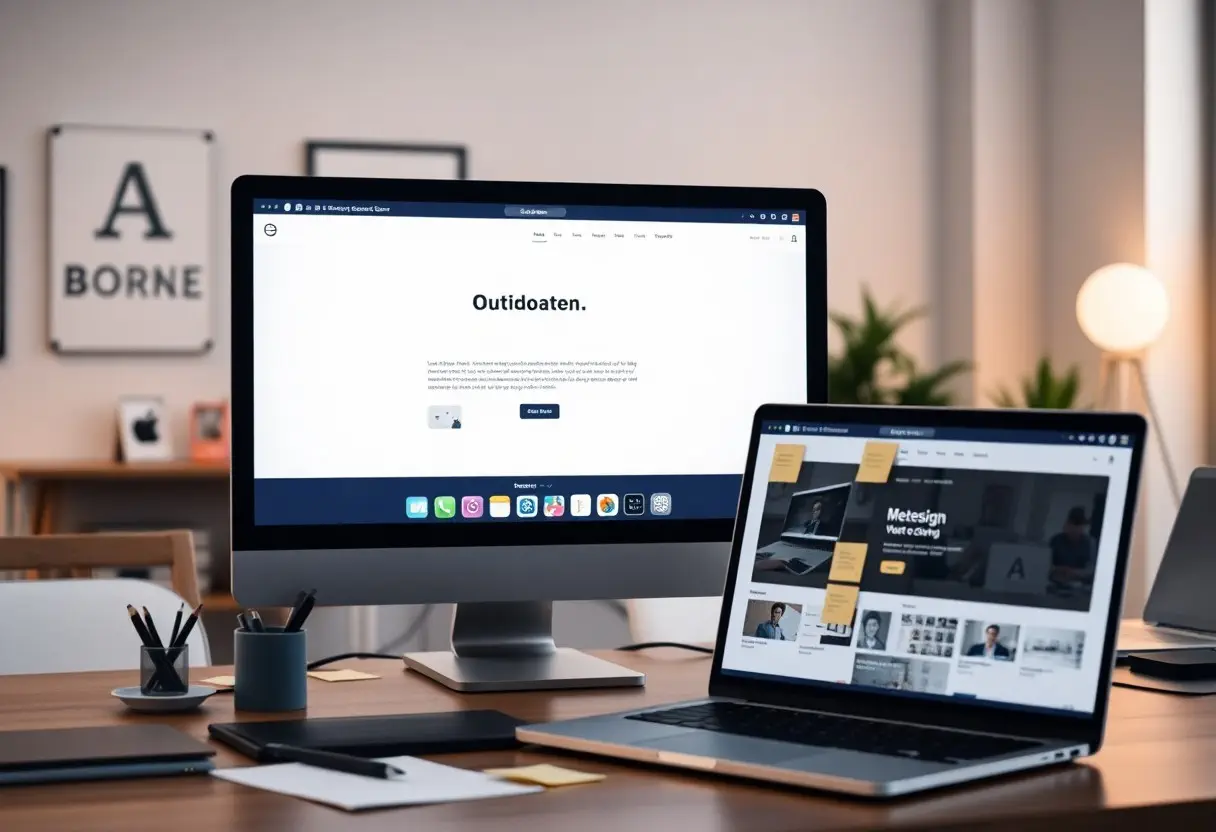
Redesigning your website can transform your online presence and enhance user experience. As technology evolves and design trends shift, it’s crucial for you to assess whether your current site meets your business goals and user needs. Understanding the signs that indicate it’s time for an upgrade can help you stay competitive in your industry. In this post, we’ll explore key indicators that suggest your website may require a redesign, empowering you to make informed decisions about your online strategy.
Key Takeaways:
- Outdated Design: If your website looks old-fashioned or doesn’t reflect current design trends, it may be time for an upgrade.
- Poor User Experience: Difficulty in navigation or slow loading times can drive visitors away; a redesign can enhance user engagement.
- Lack of Mobile Optimization: With increasing mobile traffic, a site that isn’t mobile-friendly needs immediate attention for a redesign.
- Low Conversion Rates: If your site isn’t generating leads or sales, a redesign can help optimize for conversions.
- Inconsistent Branding: If your branding has evolved but your website hasn’t, it may be time to align your online presence with your brand identity.
Understanding Website Redesign
The decision to revamp your website can significantly impact your online presence. If you’re unsure whether it’s time for a major update, Time for an Upgrade? 7 Signs it’s Time to Redesign Your … can guide you through the important signs that indicate a redesign may be necessary.
What is Website Redesign?
Above all, website redesign involves revamping the design, technology, and overall user experience of your existing site. This is not merely a visual update; it encompasses strategic changes aimed at enhancing functionality and meeting the evolving needs of your audience.
Benefits of a Redesign
On the flip side, a website redesign can lead to numerous advantages for your business. It enhances the user experience, improves search engine rankings, and can significantly increase conversion rates.
In fact, investing in a redesign can rejuvenate your brand’s image and attract a larger audience. An updated website can load faster, be mobile-responsive, and incorporate the latest design trends, all of which make it easier for visitors to navigate. These improvements can result in longer visit durations and increased engagement, ultimately driving more sales or leads for your business.

Signs Your Website Needs an Upgrade
Any business owner should keep a close eye on their website’s performance and appearance. If you notice any signs indicating that your site is lagging behind current standards, it may be time for an upgrade. Evaluating your site’s design, user experience, mobile compatibility, and loading speed can help determine whether it requires a refreshing update to keep your audience engaged and satisfied.
Outdated Design
Before entering into any comprehensive redesign, consider how your current layout and visuals resonate with today’s audience. If your website looks like it belongs in a different decade, it can negatively impact your brand image and credibility. An updated design not only enhances aesthetics but also aligns with modern user expectations.
Poor User Experience
Across your site, if visitors struggle to find information or navigate seamlessly, it can lead to high bounce rates. A poor user experience hampers engagement and can push potential customers away. Your website should act as a helpful guide rather than a source of frustration.
Even small issues, like confusing navigation or cluttered layouts, can create significant challenges for your users. If they can’t quickly find what they’re looking for or feel overwhelmed by your site’s design, they are likely to leave and seek solutions elsewhere. Ensuring a streamlined, intuitive user experience is important for retaining and converting visitors.
Lack of Mobile Compatibility
Among today’s internet users, a substantial percentage browses the web via mobile devices. If your website doesn’t provide a responsive design, you’re alienating a significant portion of your audience. A lack of mobile compatibility can lead to poor user experiences and decreased traffic.
Due to the increasing reliance on smartphones and tablets, a non-mobile-friendly site may yield frustrating experiences for users. If they have to zoom in to read text or struggle with clickable elements, they are likely to exit your site quickly. Ensuring your website is optimized for all devices is key to reaching a broader audience and maintaining user interest.
Slow Loading Speeds
Lack of attention to your website’s loading times can severely impact user retention and satisfaction. If your pages take too long to load, potential customers will likely choose to leave and seek faster alternatives. Websites should load swiftly to keep users engaged.
Needs fixing your site’s speed not only improves user experience but also contributes to better search engine rankings. Factors like large image files, unnecessary plugins, or inefficient code can all slow down your site. By addressing these issues, you enhance overall performance, leading to happier visitors and higher conversion rates.
Analyzing Website Performance
Many businesses overlook the importance of regularly analyzing their website performance. If your site isn’t meeting user expectations, it may be time for an upgrade. Understanding your website’s effectiveness can help you identify areas for improvement. To gain insights into the necessity for a new design, you can read about Website Redesign – Justifying a New Design to Your Boss.
Key Metrics to Monitor
At its core, monitoring key performance metrics can reveal how well your website is functioning. You should focus on metrics such as page load time, bounce rate, conversion rate, and user engagement. Each of these metrics provides valuable insight into how users interact with your site, helping to guide your redesign decisions.
Tools for Website Analysis
Behind effective analysis are tools that can provide deep insights into your website’s performance. Utilizing various analytics platforms can aid you in gathering data about visitor behavior, traffic sources, and overall engagement metrics.
Tools like Google Analytics, SEMrush, and Crazy Egg can help you assess your website’s performance effectively. With these tools, you can track user journeys, identify high-traffic pages, and pinpoint areas where visitors may be dropping off. By utilizing these insights, you can make informed decisions that lead to a more optimized website experience for your users.
Choosing the Right Redesign Services
For anyone considering a website redesign, selecting the right services is vital for achieving your goals. You want to partner with a team that not only understands your vision but can also deliver a high-quality product tailored to your specific needs. Take the time to research various agencies and their service offerings to ensure you make an informed decision that aligns with your business objectives.
Evaluating Web Design Agencies
Agencies that specialize in web design bring different strengths to the table, so it’s important to evaluate their portfolios, client testimonials, and industry experience. Look for a firm that has successfully executed projects similar to yours and ask about their approach to design and development. A good agency will have a strong understanding of current trends as well as the technical skills necessary for a seamless user experience.
Questions to Ask Before Hiring
Before you commit to a web design agency, it’s vital to ask targeted questions that can provide clarity on their methodology and approach. Inquire about their design process, timeline, pricing structure, and post-launch support. Furthermore, understanding how they incorporate your input into the design and whether they have the capacity to adapt to your business’s evolving needs can help ensure a successful partnership.
Redesign your website is a major investment, so asking the right questions will help establish a clear understanding between you and the agency. Consider asking about their experience with SEO, mobile responsiveness, and analytics tracking, which are key to maintaining your site’s effectiveness. Additionally, inquire about how they keep clients informed throughout the redesign process so you can feel confident about your investment from start to finish.

Planning Your Redesign Project
Once again, it’s time to assess your website and determine how to take it to the next level. Proper planning is necessary for a successful redesign project. You should consider your current website’s performance, user experience, and overall presence in your industry. Taking stock of these factors will guide you in creating a roadmap for your redesign efforts, ultimately leading to a more effective and engaging online platform.
Setting Goals and Objectives
To ensure a successful redesign, it’s important to establish clear goals and objectives that align with your business vision. Think about what you want to achieve—whether it’s improving user engagement, increasing conversions, or enhancing brand awareness. Setting specific and measurable goals will provide direction and enable you to evaluate the effectiveness of your redesign once it’s complete.
Budgeting for Redesign
One of the key aspects of any redesign project is budgeting, as it helps you determine how much you can allocate to different phases of the project. A well-planned budget ensures you have the resources necessary for design, development, and ongoing maintenance. Factor in potential costs, including tools, software, and professional services, to create a realistic budget that aligns with your objectives.
Understanding the financial implications of your redesign is vital for managing expectations and avoiding surprises down the line. Break your budget down into specific categories, such as design, development, content creation, and marketing. This will give you a clearer picture of where your funds are going and help identify areas where you might cut costs or allocate more money. Additionally, consider setting aside funds for post-launch updates and adjustments, as continuous improvement is key to keeping your website effective and relevant.
Implementing and Testing Your New Design
To ensure your redesigned website meets your goals, it’s vital to implement and thoroughly test the new design. Begin by migrating your content and features while keeping a close eye on functionality across various devices and browsers. Conduct usability testing with your target audience to identify any obstacles they may encounter. This process will help you fine-tune the design to deliver an optimal user experience, ultimately achieving the results you desire.
Launch Strategies
After completing your testing phase, strategize your launch to create excitement around your new website. Consider a soft launch to address any last-minute adjustments before a full public reveal. Promote your updated site through your email newsletters, social media channels, and even creating special offers to entice visitors. A well-planned launch will set the stage for successfully attracting and retaining users on your revamped platform.
User Feedback and Adaptation
About a week after your website goes live, begin gathering user feedback to understand their experience with your new design. This feedback is invaluable for identifying areas that may need improvement or adjustments that could enhance user satisfaction. Engaging with your audience post-launch will enable you to stay aligned with their needs and preferences, ensuring your website remains effective and relevant.
Feedback from real users provides insights that analytics alone cannot. By actively seeking opinions through surveys, comment sections, and usability testing, you can pinpoint issues and areas for enhancement. An adaptable mindset will allow you to iterate on your design, ensuring your website evolves with changing audience expectations and technological advancements. Embrace this ongoing process and make adjustments to foster better engagement and conversion rates over time.
Final Words
To wrap up, if you notice your website becoming outdated, difficult to navigate, or not mobile-friendly, it’s time to consider redesigning your site. An effective website informs and engages your audience while enhancing your brand’s credibility. If your loading times are slow, or if you’re not capturing enough leads, updating your site can significantly improve your online presence and user experience. Investing in website redesign services in New Jersey is a proactive step towards better visibility and functionality, ensuring that your online platform meets current standards and drives success.
FAQ
Q: What are some signs that my website needs a redesign?
A: There are several indicators that it might be time to consider a redesign for your website. If your site has a high bounce rate, meaning visitors leave quickly without engaging with your content, or if it’s not mobile-friendly, it could benefit from an upgrade. Additionally, outdated graphics or layout can make your site appear unprofessional. If your website is not SEO-optimized, leading to low search engine rankings, or if you are unable to update content easily, those too are signs it’s time for a redesign.
Q: How can a website redesign improve my online visibility?
A: A redesign can enhance your website’s SEO by incorporating modern practices, such as faster loading times, responsive design, and improved navigation. By redefining your site’s structure and optimizing content for search engines, you increase the chances of higher rankings on search results, which attracts more traffic. Additionally, a visually appealing design can lead to better engagement and reduced bounce rates, ultimately aiding visibility.
Q: Is a complete redesign necessary, or can I make minor updates instead?
A: The decision between a complete redesign and minor updates depends on the current state of your website. If your site meets some modern usability and SEO standards but appears outdated, minor updates may suffice. However, if the foundation is significantly flawed, a full redesign might provide the comprehensive improvements needed to align with current web trends and user expectations.
Q: How do I choose the right web design service in NJ for my project?
A: When selecting a web design service, consider their portfolio and client testimonials to assess their past work quality. It’s important to find a company that understands your industry and can tailor their services to your specific needs. Additionally, check if they offer ongoing support and maintenance, which can be valuable after your site goes live. Scheduling consultations with multiple providers can help gauge their communication styles and expertise.
Q: How long does a website redesign typically take?
A: The timeline for a website redesign can vary significantly based on the project’s complexity and the service provider’s schedule. On average, a redesign can take anywhere from a few weeks to several months. Factors that influence the duration include the size of the site, the level of customization required, and how quickly content and feedback are provided by the client. It’s best to discuss timelines during the initial consultation with your chosen design service.




